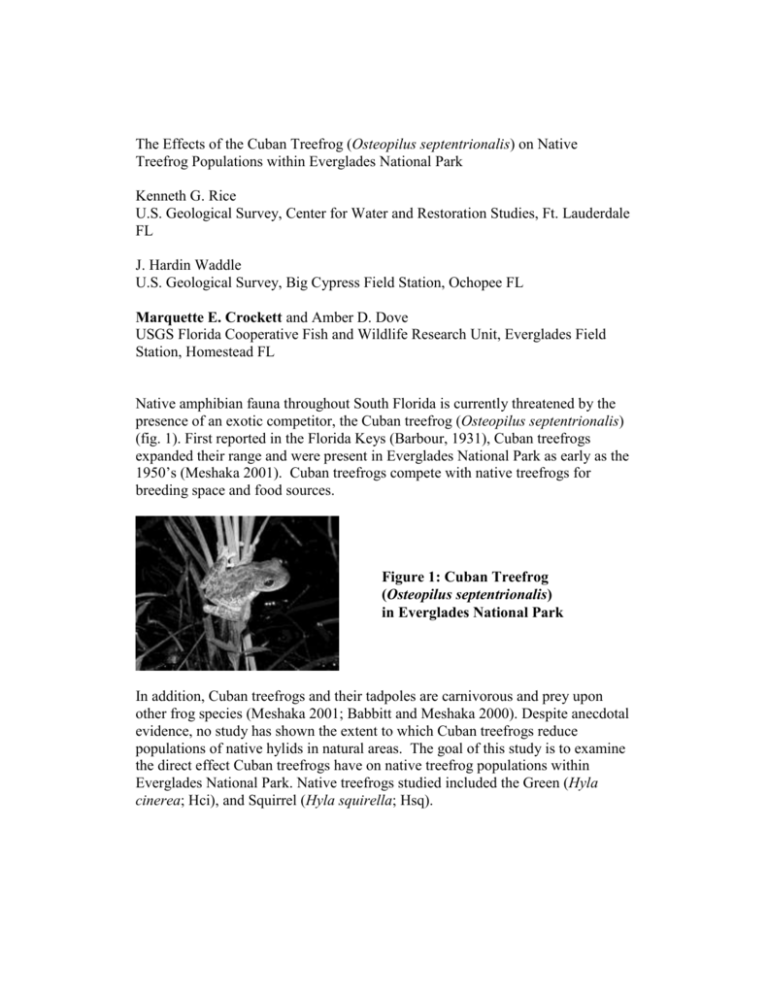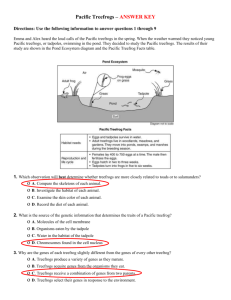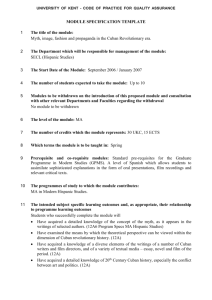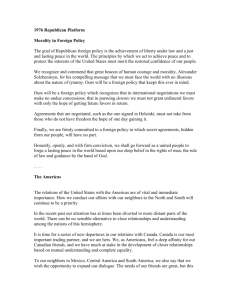The Effects of the Cuban Treefrog (Osteopilus septentrionalis)
advertisement

The Effects of the Cuban Treefrog (Osteopilus septentrionalis) on Native Treefrog Populations within Everglades National Park Kenneth G. Rice U.S. Geological Survey, Center for Water and Restoration Studies, Ft. Lauderdale FL J. Hardin Waddle U.S. Geological Survey, Big Cypress Field Station, Ochopee FL Marquette E. Crockett and Amber D. Dove USGS Florida Cooperative Fish and Wildlife Research Unit, Everglades Field Station, Homestead FL Native amphibian fauna throughout South Florida is currently threatened by the presence of an exotic competitor, the Cuban treefrog (Osteopilus septentrionalis) (fig. 1). First reported in the Florida Keys (Barbour, 1931), Cuban treefrogs expanded their range and were present in Everglades National Park as early as the 1950’s (Meshaka 2001). Cuban treefrogs compete with native treefrogs for breeding space and food sources. Figure 1: Cuban Treefrog (Osteopilus septentrionalis) in Everglades National Park In addition, Cuban treefrogs and their tadpoles are carnivorous and prey upon other frog species (Meshaka 2001; Babbitt and Meshaka 2000). Despite anecdotal evidence, no study has shown the extent to which Cuban treefrogs reduce populations of native hylids in natural areas. The goal of this study is to examine the direct effect Cuban treefrogs have on native treefrog populations within Everglades National Park. Native treefrogs studied included the Green (Hyla cinerea; Hci), and Squirrel (Hyla squirella; Hsq). Population estimates for treefrogs were obtained through a mark-recapture study using PVC refugia. Five study plots were selected within Everglades National Park (2 mangrove and 3 pine rockland sites). Two of these sites are near disturbed areas, while all others are fairly remote. After initial population estimates were obtained, Cuban treefrogs were removed from sites to examine the recovery of native populations. Additionally, predation of hylids by Cuban treefrogs was quantified through stomach content analysis of removed animals. To date, approximately 2,200 individual frogs have been included in this study. Preliminary results indicate Cuban treefrogs are more numerous in plots 501 and 101, which are located near disturbed areas, while remote sites contained larger populations of native species (fig. 2). Initial results indicate that native populations significantly increase as Cuban treefrogs are removed. The largest population increases occurred at sites where Cuban treefrogs were originally most dense (table 1). Preliminary analysis of stomach contents suggest that predation on hylid treefrogs is higher in mangrove than pine rockland sites. 800 700 600 500 Ose Native 400 300 200 100 0 101 501 Shark LPK-W LPK-E Figure 2: Total captures of Cuban (Ose) and native treefrogs in study plots within Everglades National Park from November 2000 to November 2002 Table 1: Mean number of captures per visit of Cuban (Ose), Green (Hci) and Squirrel (Hsq) treefrogs before and after removal of Cuban treefrogs in sites 101 and 501 (* statistically significant) N (NUMBER VISITS) PREREMOVAL N (NUMBER VISITS) POSTREMOVAL 501-Ose 30 8 28.100 (± 5.497) 30.375 (± 5.928) 501-Hci * 30 8 1.533 (±0.328)* 19.500 (± 6.743)* 501-Hsq * 30 8 0.267 (± 0.117)* 1.500 (±0.886)* 101-Ose 29 7 15.414 (±3.260) 13.714 (±2.476) 101-Hci 29 7 1.517 (±0.411) 0.143 (±0.143) 101-Hsq * 29 7 0.379 (±0.104)* 3.571 (±1.343)* SITE AND SPECIES MEAN CAPTURES PRE-REMOVAL MEAN CAPTURES POST-REMOVAL To adequately monitor the effects of Cuban treefrogs on native populations, this study will continue until Fall 2003. After completion, the results of this study may be used to identify factors that facilitate or obstruct dispersal of Cuban treefrogs into natural areas. In addition, this information will be incorporated into an ArcInfo model of the potential spread and impact of Cuban treefrogs on native species in protected areas. Data will be available to cooperating agencies and the public. Literature Cited Babbit, K.J. and W.E. Meshaka. 2000. Benefits of eating conspecifics: Effects of background diet on survival and metamorphosis in the Cuban treefrog (Osteopilus septentrionalis). Copeia 2000(2): 469-474. Barbour, T. 1931. Another introduced frog in North America. Copeia 1931(3): 140. Meshaka, W.E. 2001. The Cuban Treefrog in Florida – Life History of a Successful Colonizing Species. University Press of Florida. Marquette E. Crockett, USGS - Florida Cooperative Fish and Wildlife Research Unit, Everglades Field Station, 4001 SR 9336, Homestead FL 33314 Phone: 305-242-7800 x7333, FAX: 305-242-7834 marquettecrockett@hotmail.com








